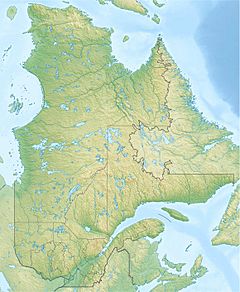Aux Pékans River facts for kids
The Aux Pékans River (in French, Rivière aux Pékans) is a river located in the Côte-Nord region of Quebec, Canada. It flows into the Moisie River, meaning it's a smaller river that joins a larger one. In the early 1990s, there was a plan to change the river's path to help power a hydroelectric plant, but this idea caused some discussion.
Quick facts for kids Aux Pékans River |
|
|---|---|
| Country | Canada |
| Province | Quebec |
| RCM | Caniapiscau |
| Physical characteristics | |
| River mouth | Moisie River 52°12′23″N 66°48′38″W / 52.206353°N 66.810650°W |
| Basin features | |
| Basin size | 3,419 square kilometres (1,320 sq mi) |
Contents
Where is the Aux Pékans River?
The Aux Pékans River is located in an area of Quebec called Rivière-Mouchalagane. This area is part of the Caniapiscau Regional County Municipality. The river's name became official on December 5, 1968. No one knows for sure how it got its name.
The river starts in a lake called Lac de la Bouteille. This lake is south of Lake Germaine and west of the town of Fermont. The river then flows past the Mont Wright mines. A road, Quebec Route 389, crosses the Aux Pékans River just south of Fermont.
The Aux Pékans River generally flows towards the south-southeast. Near its end, it turns northeast and joins the Moisie River. The Aux Pékans River drains an area of about 3,419 square kilometers (1,320 square miles). It is the second most important river that flows into the Moisie River.
Rivers that Join the Aux Pékans
Several smaller rivers flow into the Aux Pékans River. These are called its tributaries.
- The Grasse River joins from the south.
- The Carheil River joins from the north.
- The La Ronde River also joins from the south.
The Carheil River starts in Carheil Lake. This lake is located south of Fermont and Quebec Route 389.
River Environment
The Aux Pékans River flows through a natural area known as the boreal zone. This zone is covered by spruce trees and moss. The river starts in an area with spruce and lichen, then flows through an area with spruce and moss. This type of environment is typical for northern Quebec.
Plans to Divert the River
In the early 1990s, a company called Hydro-Québec had a plan. They wanted to build a new hydroelectric power plant called SM-3. This plant would create a lot of electricity. To do this, they planned to change the path of the Carheil and Aux Pékans rivers. This change is called a diversion.
The Innu people, who live near the mouth of the Moisie River, were worried. They were concerned that diverting the rivers would affect the water quality and the number of salmon in the Moisie River. Salmon are very important to their way of life. However, some other Innu communities in Sept-Îles were more open to the project.
A report in 1994 looked at what would happen if the rivers were diverted. It found that changing the river's path would affect water temperature. Water temperature is very important for Atlantic salmon. The report suggested the Moisie River might get slightly warmer.
After much discussion, a special commission looked into the project. They decided that diverting the rivers was not a good idea for the economy. They also believed it could harm the salmon population in the Moisie River.
In the end, the government decided to protect the Aux Pékans and Carheil rivers. On February 6, 2003, the Quebec government made a decision. They gave full legal protection to the Moisie River and its tributaries, including the Carheil and Aux Pékans rivers. This means these rivers cannot be diverted.
See Also


